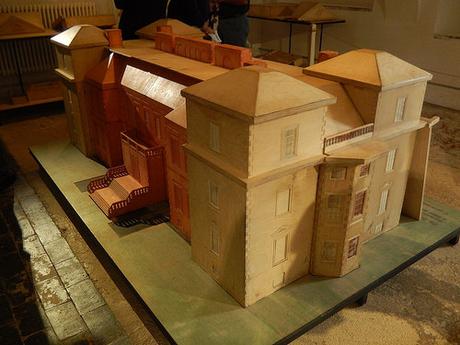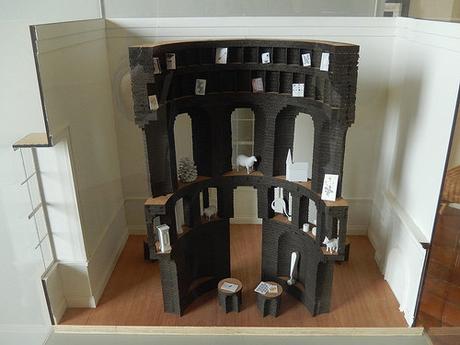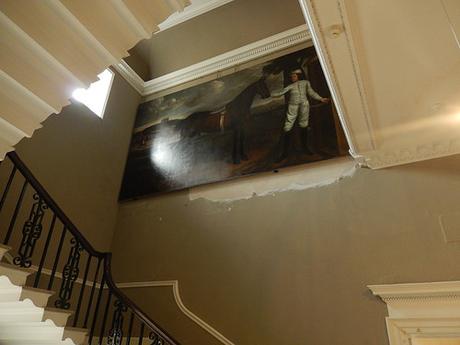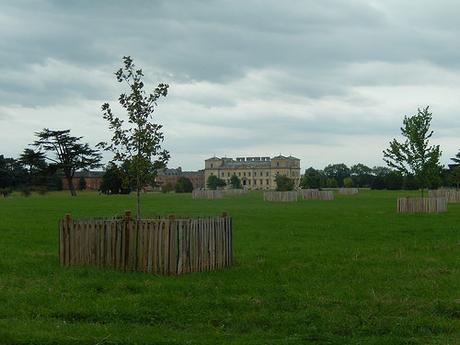Saturday 24th September 2016
There are many benefits to being a National Trust member. When my annual renewal came up a few months ago, I was presented with a free pass for a friend, along with a new membership card for the twelve-months ahead.

This was only valid until the end of September and a few properties were excluded from the deal. We discussed a few ideas over where to go and mostly came up with a list of places that one of us had already been to… In the end, we settled upon a trip to Worcestershire to visit Croome.
I was only really aware of Croome because I’d seen road signs for it on previous trips up to Great Malvern. Among other National Trust members and visitors I’ve spoken to, it appears to be largely unknown.

Perhaps it’s a bit like the Shropshire Hills… Where people are too often driving north to the Peak and Lake District, west to Wales or heading south towards the coast… Whichever way, Shropshire is easily bypassed.

From the car park, we made our way through the entrance, past the National Trust shop with a range of curious collectables stacked outside and then on towards the house.

Beyond the woods and the trees, the landscape opened out, with peaks of the Malvern Hills far ahead of us. Before heading on to the house, we decided to explore St. Mary Magdalene Church (not owned by the National Trust). Outside of which, a group of Ramblers had assembled for the start of their walk; using the building as shelter from the cold wind.

Inside we were greeted by a man who was too happy to tell us much about the church history and his own family’s significance with it.

Its original location was down beside the house, before it was eventually ‘moved’ and reconstructed higher up the hill.

Outside the church, we continued our walk (as indicated on the National Trust’s leaflet) to discover Croome’s Ice House. How would people have climbed in and out of these things?

We then discovered a shed-like bird hide and, upon opening the viewing windows, we noticed there were birds everywhere. This was probably the most active bird-watching area I’ve been to (not that I could name or identify anything other than a robin). Before we eventually left, I hissed at a black cat that had crept in to view, stalking its prey… It didn’t hang around.

We then arrived at the Rotunda – a building whose roof and interior had been restored only a few years already, following the National Trust’s purchase. There’s seating inside and, aside from the rattle of wooden windows, you’ll find shelter from the wind, inside.

One of the footpaths nearby had been closed due to fallen trees in these high winds. Not that it affected our route the house.

We spotted an ancient roundabout, where the wooden decking appeared to be in reasonable condition – funny, how these things look so much smaller than you might remember. Were we ever really that small?

I tried to crop the portaloo out of this shot but the door kept swinging open in the wind, violently, and nearly knocked Jodie to the floor as we walked past.

Make what you will, of Lancelot ‘Capability’ Brown’s Sphinx!

One of the first rooms we entered happened to have a series of art installations on display – days earlier, Grayson Perry had been exhibiting here.

I forget the intention behind each piece by, without a doubt, the most bizarre one was the pair of inflatable arms and legs, protruding from the end wall… Off camera, there were patches of plaster missing from the bare walls beneath the cornice.

In the next room was this substantial pair of sideboards, with a video display showing how it opened up to reveal a series of drawers on either side.

From the ground floor, we gradually descended in to the basement – which was strange, since several windows indicated we were only partially beneath ground level. Down here, we found a café selling tea and cake. It also happened to be quite warm and not packed with people.

Further down the hall, we found a model of the house and how it was shaped by Capability Brown – essentially, applying a ‘skin’ of Bath stone (birch plywood, in the model) over the original structure. It was fun, being able to take the model apart and (attempt to) rebuild exposed sections. A lot of work must’ve gone in to this!

I think it was at this point that we attempted to made our way back along the corridor and towards the stairs… Only to find a tour group obstructing our path.

In a cunning attempt to bypass them, we walked back through the café and to a closed door that would lead us to the foot of the stairs… Only, on the other side, we found the same group had shuffled further along simultaneously and were still standing in our way! Unable to sneak past, we pretended to be interested until our opening emerged – it was either that or, we would’ve burst out laughing at the hilarity of the situation. For a few minutes, we’d left reality to enter a cartoon world.
There was a room with lots of shoes… I’ve no idea what that was for.

Up on the first floor, we passed through the first in a succession of bedrooms with ‘dated’ décor.

There was a huge “bathroom”… Bathtub in the center of the room; toilet by the window; sinks at the other end and no doors preventing access from either side… Perhaps that chair is the biggest mystery of all.

In one room, there were two options for proposed future developments and art installations to fill the space.

One is like a multi-dimensional spiralling bookcase; the other, something like a partial Colosseum?

There was significance to this painting – and not purely because it was hiding an exposed or unfinished wall – because there’s a building featured in the background that has no recorded existence in the history of Croome Court.

This first floor is in need of repair work. It’s worth mentioning that the National Trust purchased this on a lease from Croome Heritage Trust. If they owned the property outright, perhaps work would already be under way?

I had a bit of a ‘facepalm’ moment when I noticed the piece of pine spliced in between two lengths of oak on this handrail. Note, also, the deadly-sharp corners.

Soon after that, we were outside again and looking to cross over the Chinese Bridge.

If you’ve read or seen anything of Croome Court previously, you’re probably aware of the house… It remains a mystery as to why this lake and landscape aren’t given more exposure. In my opinion, it’s almost up there with Stourhead (which I visited, for the first time, only a few days before writing this).

I’d never seen deck chairs available at a National Trust property, either.

Croome also has its own Grotto. It may lack the stone arches and length of the one at Stourhead but, it remains interesting, nonetheless.

A series of statues could be found around the parkland.

Our tour ended with the greeting of Pan.

By now, we were a bit pressed for time, as we had intended to make another stop before driving back down the M5.

Before leaving, we spent some time exploring the RAF Defford museum, were we learnt about how a portion of the Croome estate held a top-secret base back in the Second World War. Beside that was also a canteen serving hot food and bookshop.

I was certainly impressed by all that we found and saw at Croome as there seems to be much more available than the small portion that is commonly advertised. I hope that more people will make an effort to visit it, in hope that repairs can one day be made to parts of the interior.
